Disadvantages Of Limestone Flooring & Common Problems – Are They Worth Getting?
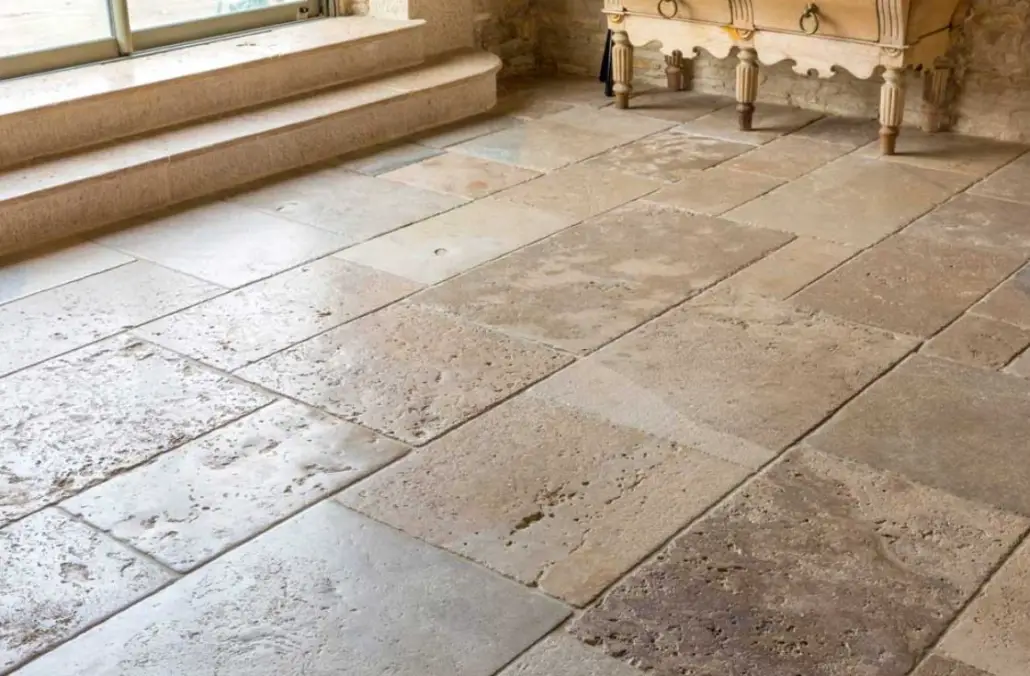
Choosing a material for flooring can be a tricky task because it is a big commitment and you will have to live with that decision for a long time.
Limestone flooring is again growing in popularity and it can be a great option, but it is important to understand all the disadvantages and problems before you make the decision.
To make sure you get no unwanted surprises, we will be looking at all the common problems of limestone flooring (as well as the upsides). By doing so we hope to help you make an informed and confident decision.
Introduction to Limestone Flooring
Limestone is a sedimentary rock, meaning it was formed from minerals that settle on top of each other and become compressed.
It normally has a white colour and it has been used in construction for centuries. Construction with limestone goes back as far as the Great Sphinx, and probably even further.
Today it is a popular option for flooring because it gives a very organic and warm feel while also giving great quality.
The Main Disadvantages of Limestone Flooring
The main disadvantages of limestone flooring include the high and ongoing maintenance such as sealing the floor periodically, the softness of the stone which leads to damage, the high price of installation and upkeep compared to alternatives, limited durability, and the heavy weight of the tiles which complicates handling.
What Are The Different Types Of Limestone Floor
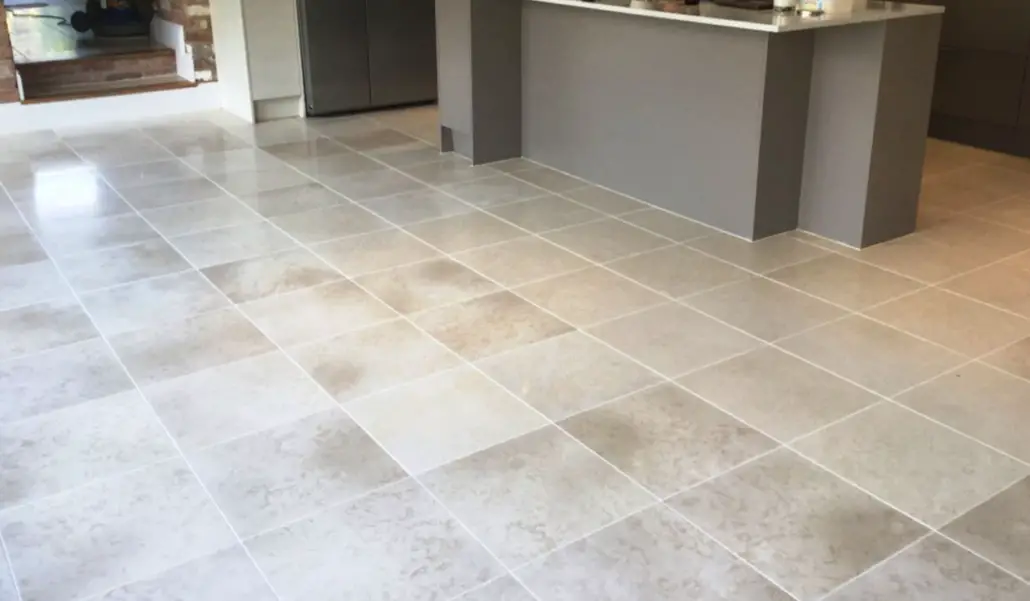
As described by Southland Stone, limestone contains small amounts of other minerals like quartz, pyrite, feldspar, siderite, and others.
Due to the presence of these minerals, the colour of limestone varies – it can be grey, blue, green, brown, and more. The texture will also vary.
Besides the different textures and colours, there are also different ways to use limestone for flooring. The most popular way is definitely to make limestone tiles.
The tiles can have a different look depending on the type of finish. The most common finishes include:
- Polished Limestone: The pores are filled and the tiles are polished to create a smooth and shining surface.
- Honed Limestone: Pores are also filled, but the polish is done lighter to create a matte finish.
- Tumbled Limestone: Round edges and corners together with other stones.
- Brushed Limestone: Finished with a wire brush to create a completely matte look.
There are also different tile patterns like a spiral pattern, herringbone pattern, french pattern, and antique pattern.
Disadvantages Of Limestone Flooring
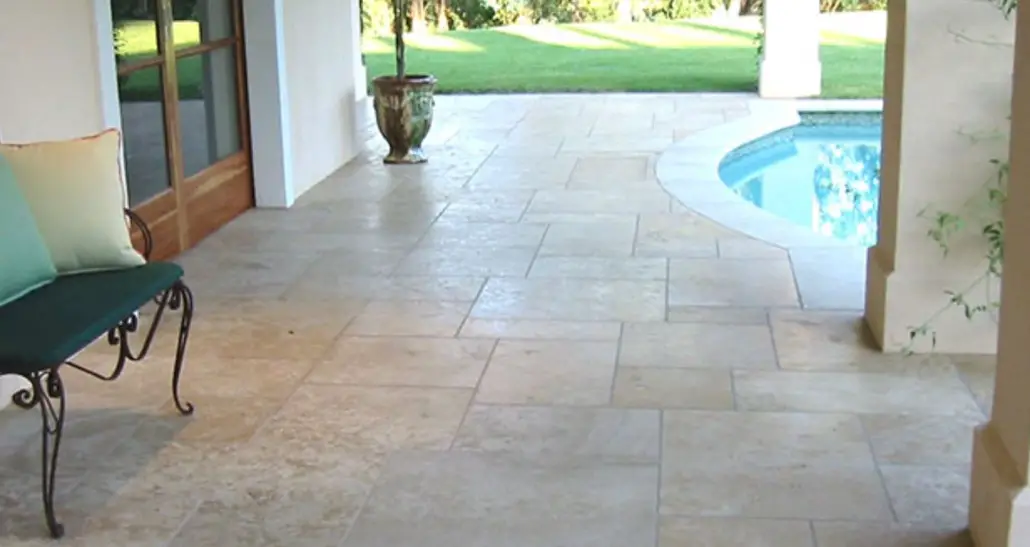
Soft Stone
Limestone is a very soft stone, it is nowhere nearly as hard as granite and marble. This does have its advantages, but it also has some serious disadvantages.
Limestone floors can easily be damaged due to the softness of the stone. In areas where there is heavy foot traffic or where there is heavy furniture, you risk the danger of damaging the floor.
More Expensive Than Certain Alternatives
Limestone is a natural rock which automatically makes it more expensive compared to other synthetic materials.
It is understandable because an organic rock floor will always be more expensive than artificial alternatives, but alternatives can still give you a synthetic rock look while saving you some money.
It Needs To Be Sealed Periodically
To get the best look and prevent unwanted stains, limestone floors need to be sealed periodically.
Limestone is a porous material so it will quickly absorb oils that will lead to discolouration. By sealing limestone you close off these pores so that the limestone stays protected.
To see what it looks like when an old limestone floor gets cleaned and sealed, view this video.
Requires Regular Maintenance
Regular maintenance is required to keep limestone floors in a good condition. Along with sealing it periodically, you may also need to repair any damage or anything else that needs maintenance.
The softer the type of limestone that you use the more maintenance it will require. This will also prove costly over the long run.
Heavy Weight Of Limestone Tiles
Limestone is a dense and porous natural rock, which makes limestone tiles very heavy. The heavy weight can make it difficult to handle, transport and install the floor. You will need someone who is experienced in handling and installing these tiles to do a limestone floor.
Limited Durability
Although limestone is a natural rock, it is a sedimentary rock. This means that it was formed from layers of organic matter that have been compacted. This does not make it exceptionally strong it is very limited in its durability.
As we have seen, it is in danger of damage and it will take maintenance to keep it in a good condition.
More Expensive Than Alternatives Long Term
The long-term cost of a limestone floor is also something that needs to be considered. As we have mentioned, it can take a lot of continuous maintenance and the costs add up.
Other materials might even be more expensive to install, but due to their low maintenance costs, they will work out cheaper over the long term.
Might Chip Or Break Over Time
As we have mentioned, and as confirmed by Designing Idea, limestone is a soft rock which makes it easy to break or chip over time.
In areas where there is a lot of foot traffic or where there is heavy furniture, it is especially dangerous for a limestone floor. In areas where things might fall like in a kitchen, it is also common for limestone floors to chip.
Not That Easy To Install
Installing a limestone floor is the job of a specialist. Even just transporting limestone tiles can be a tricky task due to their heavy weight.
Installing them also takes an expert otherwise you might end up with initial damage and installation defects. A faulty installation can also cause many problems down the line like crumbling, cracking, or discolouring.
Common Problems Of Limestone Flooring
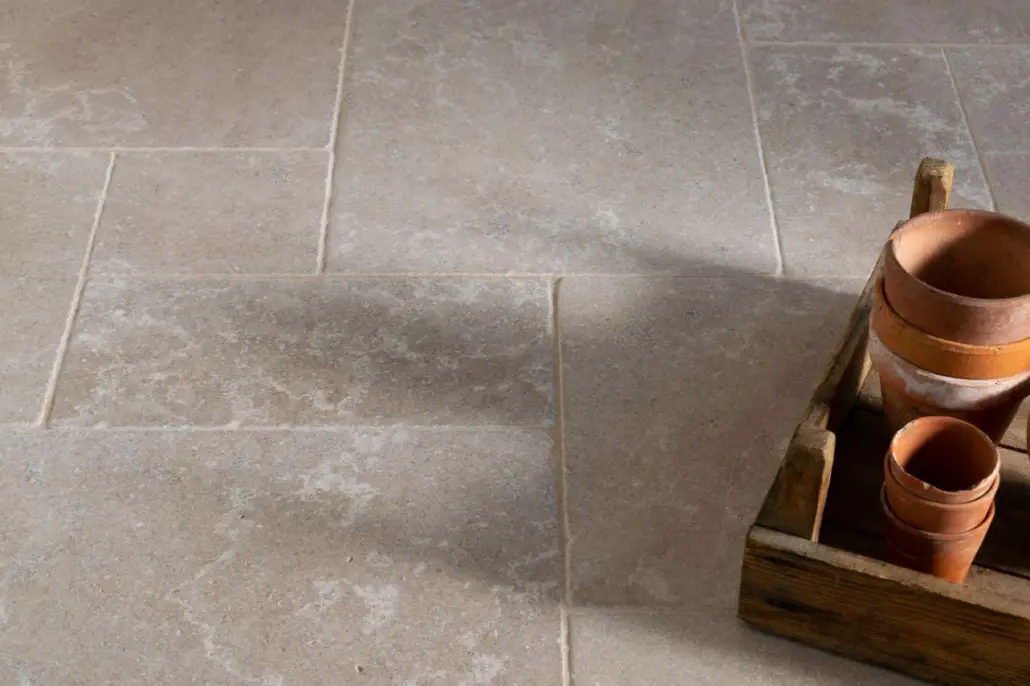
Weather
One of the most common problems that we see with limestone is how quickly it can weather. Limestone is much more prone to weathering compared to other stones like granite.
According to Sefa Stone, limestone contains calcium carbonate which reacts with the carbonic acid in acidic rainwater.
This means that rainwater can cause significant damage to limestone, so it needs to be protected. The best way to protect your limestone flooring from weathering is to keep rainwater away from it.
Erosion
Erosion is also a very common problem. We see this more often with limestone walls like the outside walls of a building, but it can also apply to flooring.
In combination with exposure and water and/or rainwater, as mentioned above, wind can also add to erosion. There are airborne abrasives that will slowly erode the limestone.
Staining
Discolouration of limestone, or staining, is another common problem that needs to be dealt with. Limestone is adored for its aesthetic appearance, so any unwanted stains can spoil it.
Limestone absorbs all kinds of organic and inorganic oils and it causes the colour to change. To prevent this it is important to keep it very clean and to only use products that are specifically tested and approved for limestone.
Crumbling
Limestone has a fairly brittle structure so crumbing is a very common issue. It can be caused by either weakness in the limestone or by the gradual breakdown of the binding material used.
Once it starts crumbling there is no real way to save it, the best method is prevention.
Cracking
Cracking is also very common similar to crumbling. Although, cracking is not such a serious issue compared to crumbling. It is still something you want to avoid because it will mess up the aesthetics of your floor. Using the correct method will help prevent cracking.
Incorrect Installation
The next most common issue is incorrect installation. Many times people are not experienced enough with limestone floors and they make mistakes which lead to any of the above-mentioned issues. To avoid this, contract a highly recommended limestone flooring expert.
The Upside Of Limestone Flooring
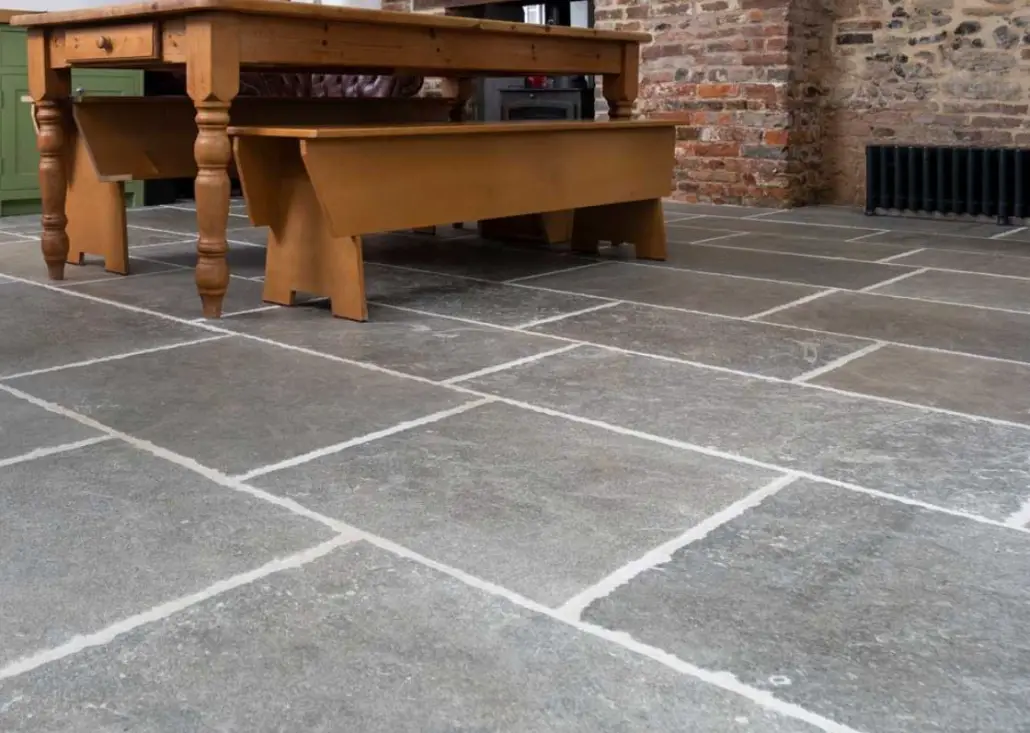
Organic Beauty
Nothing compared to the organic beauty of a limestone floor. It gives that old rustic look that only old stone floors can give, but its beauty surpasses most other stone options.
You can also personalise a limestone floor to match your needs due to the variety of colours, shades, and styles.
Sizes Can Be Customized
Limestone is a much softer stone when compared to other stones like granite. This makes it easier to cut and customize different sizes.
As stated by Sefa Stone, you can choose from large tiles to small floor tiles and even mosaic designs that are made from very small pieces of limestone.
Versatility and Workability
One of the biggest benefits of working with limestone is its versatility and workability. As mentioned above, limestone is a soft stone so it can easily be cut and worked. It can also be modified in a large number of ways to get different designs.
Friendly to the Environment
Preserving the natural environment has become more and more important over the years, and rightfully so. Options that are friendly to the environment are highly preferred, and limestone is one of them.
Compared to synthetic tiles, limestone requires very little manufacturing so it has a small footprint. This is one of its biggest advantages.
Less expensive than natural stones
Stone flooring will never be cheap, but keeping the expenses down is a big concern for most people. Choosing a limestone floor over other natural stone floors like marble or granite will save you a lot of money.
Limestone is much more abundant compared to other stone materials and it also requires a lot less labour and processes to prepare it for flooring.
Cheaper Installation Than Granite And Marble
Adding to the previous point, limestone is not only a cheaper stone, but it is also much cheaper to install compared to other natural stones like granite and marble.
It is easier to work with, takes less time and effort, less manpower, and the installation process is much quicker. All of these things add to the more affordable price of limestone.
Has Been Used Since Ancient Times – Not just a fad
Although limestone floors are very popular right now, it is nothing new. Limestone has been a favoured building material for centuries.
Many ancient buildings like the Great Sphinx and countless castles have used limestone in their construction. This gives us a good idea that we can trust its quality.
Comparisons
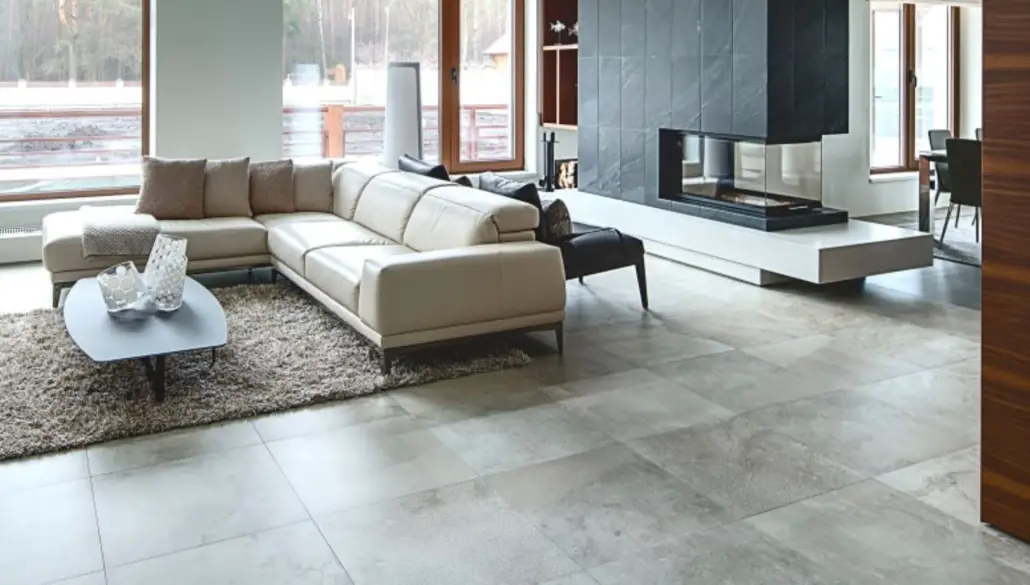
Limestone vs Slate Flooring
The main difference here is that slate flooring is stronger than limestone and it absorbs less water. This makes slate ideal for outdoor patios where it will get more weathering and damage. Limestone gives a much warmer and earthier feel so it is commonly preferred inside.
eHow describes in more detail how these two compare.
Limestone Flooring vs Travertine
Both limestone and travertine are great natural stones that make for beautiful floors. The main difference here is that travertine is more porous so it is less suitable for areas where a lot of water can damage it, like a kitchen or next to a pool. Travertine also gives a darker aesthetic.
Limestone Flooring vs Porcelain Tile
Limestone and porcelain are very different materials. Porcelain is a sintered material that is composed of various other raw materials. In terms of characteristics, porcelain is much harder, and more scratch-resistant, but it can also become very slippery when wet.
Sandstone vs Limestone Flooring
Both sandstone and limestone are great natural stone options for flooring. They are both sedimentary stones and their main difference is their material composition. In terms of characteristics, they are fairly similar.
Limestone is normally a bit cheaper while sandstone is a bit more durable.
Limestone vs Marble Flooring
Marble is another great option for a stone floor. Marble is more expensive compared to limestone, but it is more durable. Both are porous stones, but limestone is more porous so it requires more maintenance.
Limestone vs Granite Flooring
Granite is a very expensive rock so granite flooring is not an affordable option, but the beauty and quality are matched by none. It is more durable than almost any other rock, but it is also extremely heavy.
Limestone Flooring Frequently Asked Questions (FAQs)

Q: Are limestone floors high maintenance?
Limestone floors can be very high maintenance, but they do not have to do. It depends on the quality of the floor, where it is used, how it is treated, etc. If you choose a good place to do a limestone floor and you take good care of it – it does not have to be high maintenance.
Q: Is limestone easily damaged?
Limestone is a very soft sedimentary rock so if something heavy is dropped on it, it will most likely get damaged. These floors require extra care to keep them in good condition.
Q: How long will limestone last?
How long limestone will last is very dependent on how well it is taken care of. Also, even if it is not taken care of, it will still last a very long time, but it will start to look weathered. Many old castles are built from limestone and they still stand today.
Q: Why does limestone turn black?
When limestone turns black over time this can be due to exposure to certain chemicals in the air. This is not a good sign and it will cause the stone to radically deteriorate.
There are also limestone varieties that are naturally darker in colour, almost black.
Q: Are limestone floors expensive?
Limestone floors are expensive compared to cheaper synthetic options, but they are cheap compared to more expensive stone options. In general, limestone is a very common stone so the material itself is not that expensive.
Q: How does limestone break down?
Limestone can start to break down in several ways. The most common way is from constant exposure to harsh elements. When there is a lot of sun, wind, and rain, it will cause the stone to break down.
Q: How do you take care of limestone?
The best way to take care of it is to clean it, polish it, and seal it. In this way, you protect the stone from absorbing water.
Q: What happens to limestone over time?
Limestone can start to break down and crumble over time. It can also change colour, depending on what conditions it is exposed to. To keep this from happening you can care for the stone in a few easy steps, as mentioned above.
Conclusion
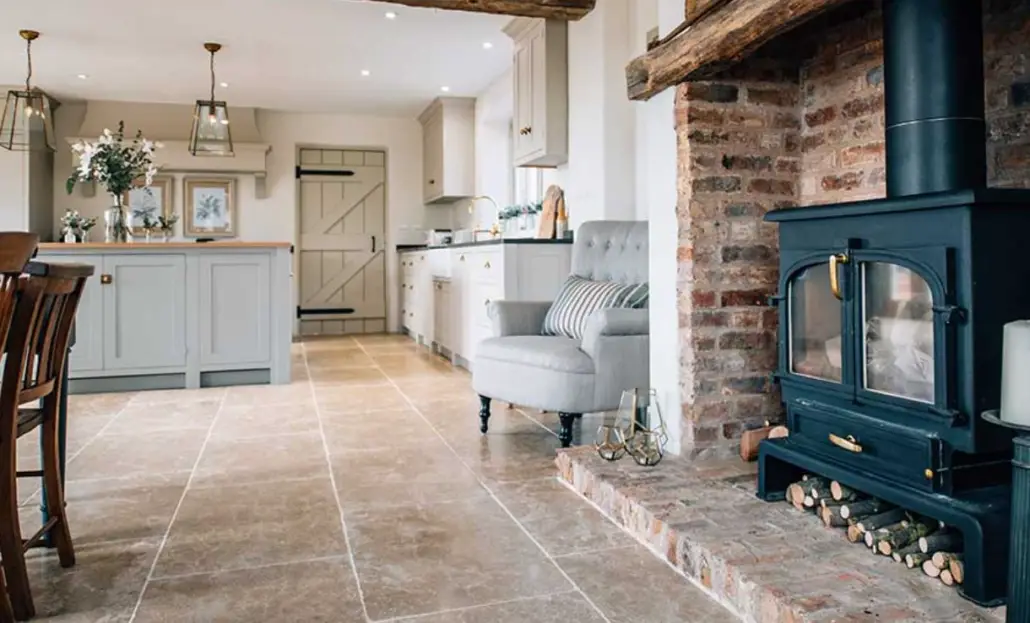
Limestone can be an amazing material to use for flooring, but it does not come without its risks and disadvantages.
Through this article, we have looked at everything there is to know about limestone floors including the different types, the disadvantages, the common problems, the advantages, how it compares to other options, as well as some frequently asked questions.
We hope that by the end of this article you have a good understanding of limestone floors so that you can make an educated decision about which floor to get.
If you have any further questions or concerns, feel free to contact us or to contact an expert in your area.

